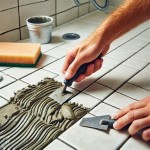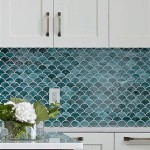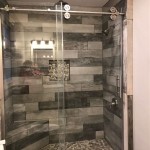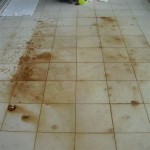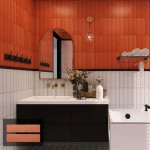Can You Use The Same Tile On Floor And Shower Walls Together?
The selection of tiles for a bathroom renovation or new construction project involves numerous considerations, including aesthetics, durability, water resistance, and safety. A common question arises: can the same tile be used on both the floor and the shower walls? The answer is not a simple yes or no, as several factors influence the suitability of a tile for different applications within a bathroom.
The primary goal when selecting tile for a bathroom, particularly the shower area, is to create a waterproof and slip-resistant surface. While using the same tile throughout can create a cohesive design and potentially simplify the selection process, it is crucial to evaluate whether a specific tile meets the functional requirements for both the floor and wall applications. Failing to do so can result in safety hazards, water damage, and premature wear and tear.
This article will delve into the key considerations when deciding whether to use the same tile on both the floor and shower walls. These considerations include tile material, slip resistance, size and weight, installation methods, and overall design aesthetics. By understanding these factors, homeowners and contractors can make informed decisions that balance visual appeal with practicality and safety.
Understanding Tile Material Properties
The material composition of a tile significantly impacts its suitability for different areas within a bathroom. Common tile materials include ceramic, porcelain, natural stone, and glass. Each material possesses unique properties that influence its durability, water absorption, and slip resistance.
Ceramic tiles are a popular choice due to their affordability and versatility. They are typically manufactured with a glazed surface, which provides water resistance. However, standard ceramic tiles may be more porous than other options, making them less suitable for areas with constant water exposure, such as shower floors. While perfectly acceptable for shower walls, their porosity may require more diligent maintenance and sealing on floors. Choose a ceramic tile specifically rated for floor use with a good PEI (Porcelain Enamel Institute) rating.
Porcelain tiles are known for their exceptional durability and low water absorption rate, making them an excellent choice for both floors and shower walls. Porcelain tiles are denser than ceramic tiles and are often rated for both wall and floor applications. This versatility makes them a practical option for creating a seamless design aesthetic throughout the bathroom.
Natural stone tiles, such as marble, granite, and slate, offer a luxurious and unique aesthetic. However, they require careful consideration due to their inherent porosity and susceptibility to staining. Natural stone tiles typically require sealing to prevent water absorption and staining. Furthermore, some natural stones can be slippery when wet, making them less suitable for shower floors. Selecting a stone with a naturally textured surface or applying an anti-slip treatment can mitigate this issue. Ensure the chosen stone is appropriate for wet environments, as some are more prone to water damage than others.
Glass tiles are often used as decorative accents on shower walls due to their vibrant colors and reflective properties. However, they are generally not recommended for floors due to their low slip resistance and potential for scratching. While some glass tiles are rated for light floor traffic, they are typically not a practical choice for high-traffic areas or areas prone to water exposure.
Assessing Slip Resistance and Safety
Slip resistance is a critical factor when selecting tile for bathroom floors, particularly in the shower area. A slippery floor can pose a significant safety hazard, leading to falls and injuries. Tile manufacturers use various rating systems to indicate a tile's slip resistance, allowing consumers to make informed decisions based on their specific needs.
The most common rating system used in the United States is the Dynamic Coefficient of Friction (DCOF). DCOF measures the force required to initiate or maintain movement between two surfaces. The higher the DCOF value, the greater the slip resistance. According to industry standards, a DCOF value of 0.42 or greater is generally recommended for level interior surfaces that are likely to be wet, such as bathroom floors and shower floors. Tiles with a DCOF value below 0.42 may be suitable for wall applications but should be avoided on floors.
Another rating system used in some countries is the R-value, which measures a tile's slip resistance on a scale of R9 to R13. R9 offers basic slip resistance, while R13 provides the highest level of slip resistance. For shower floors, tiles with an R-value of R10 or higher are generally recommended. Consider the users of the bathroom; for elderly individuals or those with mobility issues, a higher R-value is crucial.
In addition to DCOF and R-values, the texture of a tile also plays a significant role in its slip resistance. Textured tiles, such as those with a matte finish or an embossed surface, provide better grip than smooth, polished tiles. Consider incorporating textured tiles or slip-resistant additives to enhance the safety of bathroom floors.
When selecting tile for a shower floor, it is essential to consider the potential for soap and shampoo buildup, which can further reduce slip resistance. Regular cleaning and maintenance are crucial to maintain the slip resistance of any tile, regardless of its initial rating. Using a non-slip sealant can also improve the safety of the floor.
Evaluating Size, Weight, and Installation Considerations
The size and weight of a tile can impact its suitability for different applications. Larger tiles can create a more seamless look and require fewer grout lines, which can simplify cleaning and maintenance. However, larger tiles may be more difficult to install, especially on walls, due to their weight and potential for sagging.
When using the same tile on both the floor and shower walls, it is crucial to ensure that the substrate (the underlying surface to which the tile is applied) is properly prepared. The substrate must be level, structurally sound, and capable of supporting the weight of the tile. For wall applications, it is particularly important to use a high-quality thin-set mortar specifically designed for vertical surfaces. This will prevent the tiles from slipping or detaching over time.
Smaller tiles, such as mosaics, are often used on shower floors due to their increased grout lines, which provide better slip resistance. The greater number of grout lines creates a more textured surface, enhancing grip. However, installing smaller tiles can be more time-consuming and require more grout, which can increase maintenance.
The installation method also plays a crucial role in the longevity and performance of a tile installation. Proper waterproofing is essential in shower areas to prevent water damage. A waterproofing membrane should be installed beneath the tile to create a barrier against moisture penetration. This is especially critical when using natural stone tiles, which are more susceptible to water damage. Consider using a professional installer to ensure proper installation techniques and waterproofing measures are implemented.
Grout selection is also important. Epoxy grout is more water-resistant and stain-resistant than cementitious grout, making it a better choice for shower areas. Epoxy grout is also less prone to cracking and discoloration, which can improve the overall appearance and lifespan of a tile installation.
Ultimately, the decision of whether to use the same tile on both the floor and shower walls depends on a careful evaluation of the tile's material properties, slip resistance, size, weight, and installation requirements. By considering these factors, homeowners and contractors can create a bathroom that is both aesthetically pleasing and functionally sound.
In addition, design considerations come into play. While using the same tile throughout the bathroom can create a streamlined and modern look, varying tile sizes or finishes can add visual interest and depth to the space. For example, using a large format tile on the walls and a smaller mosaic tile on the shower floor can provide both aesthetic appeal and enhanced slip resistance. Consider contrasting grout colors to accentuate the tile pattern and add a design element.

Bathroom Tile Idea Use The Same On Floors And Walls

Tiles Talk Mix And Match 6 Ways To Achieve Bathroom Bliss Perini

Tiles Talk Mix And Match 6 Ways To Achieve Bathroom Bliss Perini

25 Stylish Ways To Mix And Match Bathroom Tiles Shelterness

Tiles Talk Mix And Match 6 Ways To Achieve Bathroom Bliss Perini

Matching Tiles Tips And Suggestions For Pairing Porcelanosa

Matching Floor And Wall Tiles In Your Bathroom Tile Stone

How To Choose The Best Tile For Your Shower A Bathroom Remodel Guide
Slice Of Style Three Ways To Use The Same Tile Throughout Updated Nov 2024

Tile Shower Floor Or Walls Maximizing Aesthetics With Bathroom China Ceramics Solution
Related Posts

